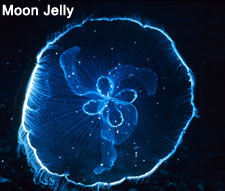
{ Characteristics }
Cnidarians have jelly-like bodies, stinging cells, tentacles, and a sac-like gut. They live in aquatic environments and there are about 10,000 species in 3 classes including hydra, jellyfish, sea anemones and corals. They have radial symmetry.
Reproduction
Cnidarians have two means of reproducing. They can reproduce either asexually or sexually.
Cnidarians reproduce asexually by budding - which usually happens in the polyp form. In one way of budding, a polyp begins swelling on its side which grow into a new polyp. In the other way of budding, polyps produce little medusas that separate and become new individual medusas.
Cnidarians reproduce sexually through external fertilization. Female release eggs into the water and male release sperm. When the sperm fertilize the eggs, they produce many diploid zygotes. Each zygote grows into a larva that will attach itself to a hard surface and develop into a polyp. The polyp buds and releases young medusas that grow into adult medusas and the cycle repeats itself.
Examples of Cnidaria
There are three classes of cnidarians: jellyfishes, hydra and their relatives, and sea anemones and coral.
The class Scyphozoa - meaning “cup animals” - contains the jellyfishes. The Moon Jellyfish, Lion’s Mane, and Cannonball Jelly are three common known jellyfishes.
The class Hydrozoa contains hydras and other related animals. Portuguese man-o-wars, fire coral, and by-the-wind sailors are three hydras.
The class Zoantharia contains sea anemones and coral.
Vocabulary
cnidocyte - stinging cells
nematocyst - a poison-filled, stinging structure that contains a tightly coiled dart
polyp -usually sessile stage of the life cycle of a cnidarian that has a cylindrical body with armlike tentacles
medusa - motile stage of the life of a cnidarian that has a bell-shaped body
gastrovascular cavity -digestive chamber with one opening
nerve net -a loosely organized network of nerve cells that together allow cnidarians to detect stimuli
hydrostatic skeleton -a layer of circular muscles and a layer of longitudinal muscles that, together with the water in the gastrovascular cavity, enable the cnidarian to move
external fertilization -process in which eggs are fertilized outside the female body
Works Cited
http://www.earthlife.net/inverts/cnidaria.html
http://www.jellyfishfacts.net/common-jellyfish.html
http://lhsvirtualzoo.wikispaces.com/file/view/hydra.jpg/208767978/hydra.jpg
http://www.dnr.sc.gov/marine/pub/seascience/images/moonjelly.jpg
No comments:
Post a Comment